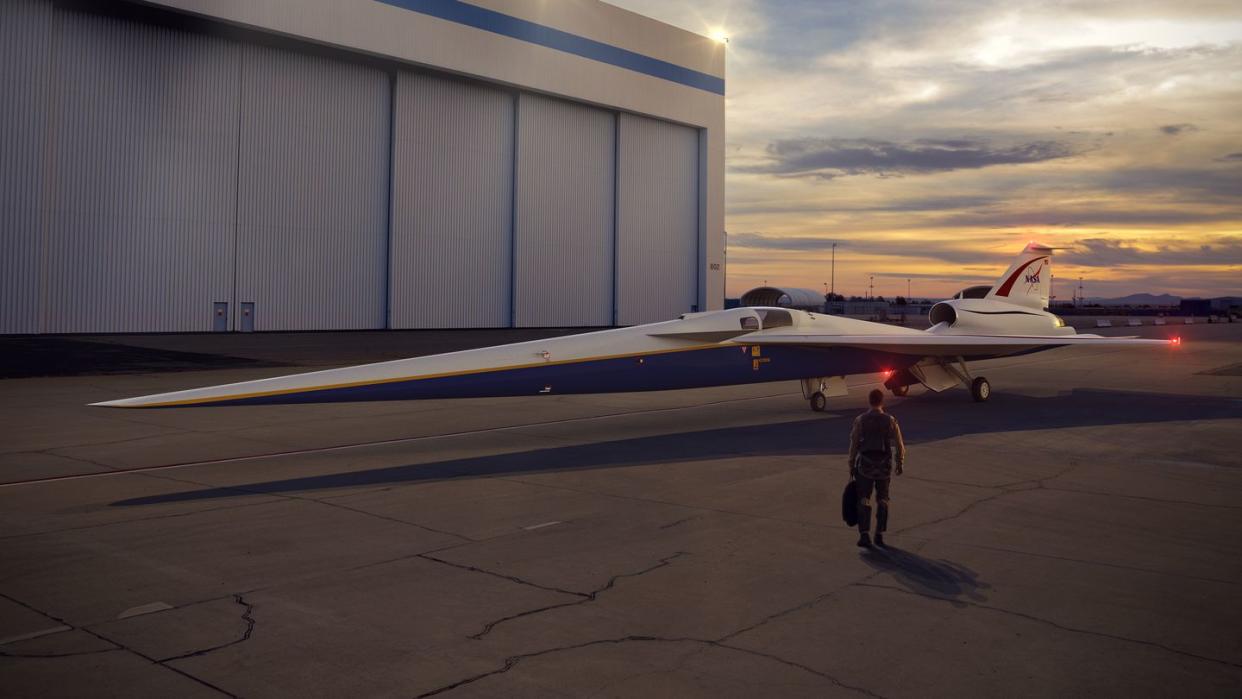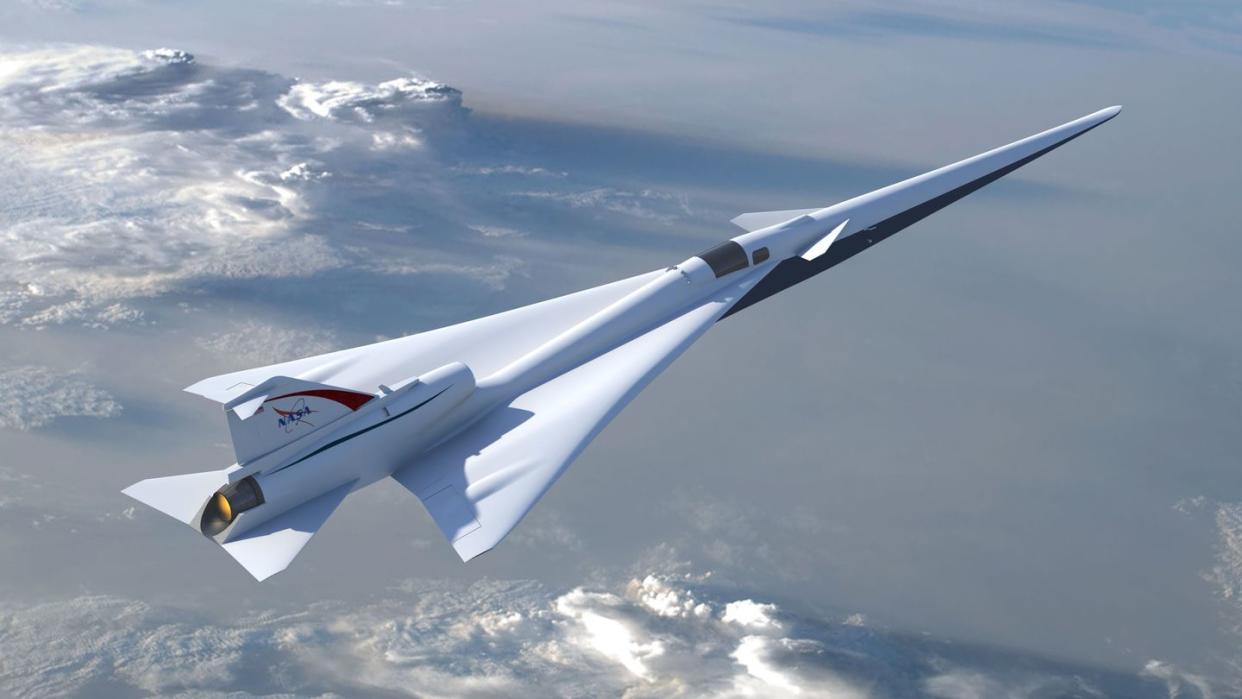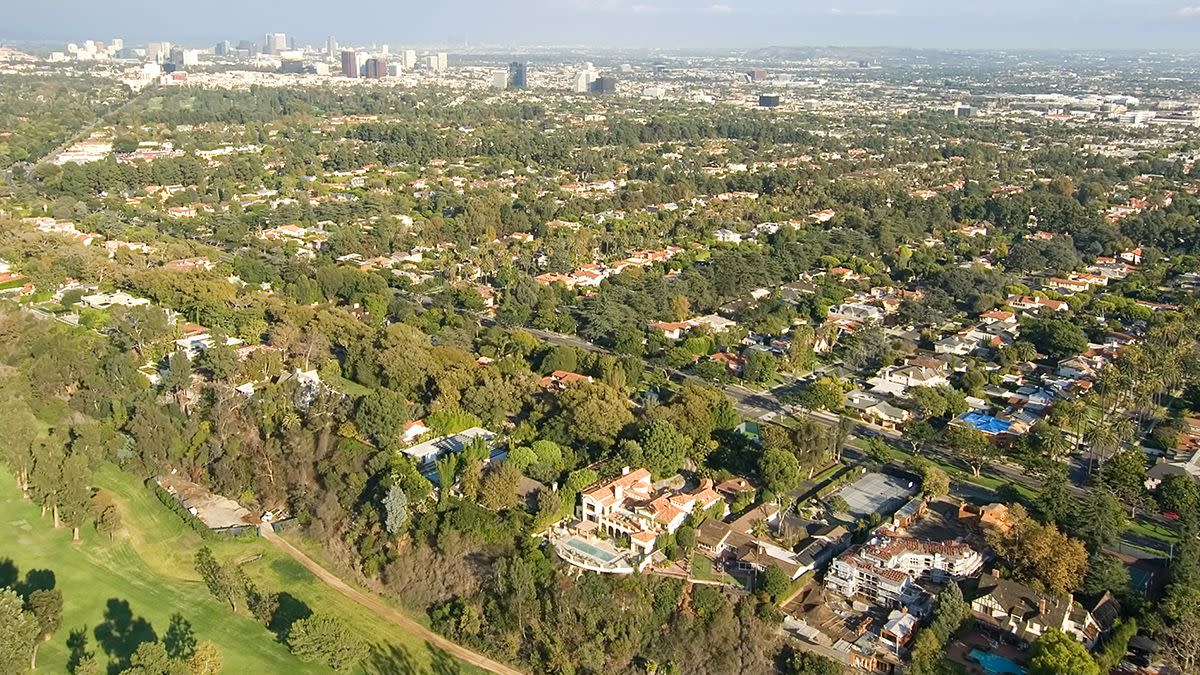Quiet Boom: Meet the NASA Test Pilot Who’ll Fly the Next Supersonic X-Plane

NASA’s newest X-plane, the X-59, is on track to match or exceed the speed of sound with a test in early 2023, the space agency says. The plane is designed to do what the X-1 supersonic test pilots did, but quietly.
Instead of a thunderous sonic boom that would disturb people on the ground, it should create a softer, less-intrusive “thump.” If successful, its technology could prove fast and safe enough for future commercial passenger transport.
✈︎ You love badass planes. So do we. Let’s nerd out over them together—join Pop Mech Pro.
Designed by Lockheed Martin, the QueSST (Quiet Supersonic Transport) X-59 will take to the skies over the Mojave Desert in California. Residents in several neighborhoods it flies over will be able to provide survey comments about any noise they notice. Based on their feedback, new regulations could lift the ban on supersonic flight over land.
“And when that happens it will mark another historic milestone in flight, potentially opening a new era in air travel, where airline passengers might hop on a supersonic jet at breakfast time in Los Angeles to make a lunchtime reservation in New York City,” according to an October 14 NASA news release.
The first time pilots attained speeds faster than Mach 1, surpassing the speed of sound, was on October 14, 1947, with the joint X-1 team of NACA, the newly formed Air Force, and Bell engineers and pilots. Test pilot Chuck Yeager is now an icon for being the first to break the sound barrier.
“That first supersonic flight was such a tremendous achievement, and now you look at how far we’ve come since then. What we’re doing now is the culmination of so much of their work,” Catherine Bahm, an aeronautical engineer at NASA’s Armstrong Flight Research Center in California, says in the release.
Because of the crack as an airplane pushes past the sound barrier, supersonic flight over land was banned in 1973.
Supersonic flight of any commercial craft ended with the final Concorde Supersonic Jet flight in 2003. In the 1960s, the Concorde became the first aircraft ferrying passengers on commercial flights. It traversed the Atlantic Ocean, from JFK International Airport to London Heathrow Airport. Facing a host of practical challenges, including cost, only 14 Concorde aircraft ever went into service.
Yet, X-plane research in both the military and scientific spheres hasn’t stopped. Engineers have a deeper understanding of how to shape an aircraft to temper the intensity of a sonic boom, particularly with NASA’s Shaped Sonic Boom Demonstration program in 2003 and 2004. At the time, the Northrop F-5E jet’s fuselage was reshaped to change the pattern of shock waves it would generate, resulting in less-intrusive sonic booms.
If successful, QueSST will demonstrate that the X-59 can regain the dream of supersonic flight for all.
In 2018, Popular Mechanics spoke to NASA’s Deputy Chief Pilot for the X-59 program, Jim Less, to learn what he expects from the X-59, an aircraft design like nothing that has ever flown before.
(The following interview has been lightly edited.)
Popular Mechanics: How does it feel to be a test pilot for NASA’s first supersonic X-plane in years?
Jim Less: Well I grew up in junior high and high school reading Popular Mechanics and Popular Science and reading about X-planes and various things that the Air Force and NASA was doing out here at Edwards—hard to believe I’m now out here doing it myself.

PM: It’s pretty special to be involved in a brand new aircraft program. How did you get started in flight test?
Less: In the Air Force. I went to college and went through Air Force ROTC, went off to Air Force pilot training, and along the way went through the Air Force test pilot school. I worked the rest of my Air Force career as a test pilot, and then retired after almost 21 years in the Air Force, and started up here with NASA coming up on eight years ago.
PM: What aircraft were you testing for the Air Force?
Less: Primarily the F-16. That was about 1999 for three years until 2002, specifically doing flight test. Then I taught at our test pilot school as an instructor for two years, and I went off and did my obligatory staff job in Washington D.C., and then got back to a little bit of flying.
PM: Are you looking forward to flying this plane more than others you’ve flown and tested?
Less: I’d say probably more. It’s a manned supersonic X-plane, those don’t come along every day. We’re doing something that hasn’t been done before, that’s the kind of thing that test pilots like to do. So I can’t wait. It’s going to be two or three years before this flies, and that’s going to be a long wait, but I know there’s a lot of work to do and it’s going to go by quickly.
PM: What else has got you excited about the X-59?

Less: The fact that it’s a unique, one-of-a-kind aircraft, and not a whole lot of people are ever going to get to fly it—that’s the kind of thing that test pilots find... professionally rewarding, let’s say. It’s also rare that you can get in on the design of an aircraft and stay with the program all the way through building it, flying it—I hope to be flying it until we’re done with the program.
We’re all very curious to see if it really works—maybe I shouldn’t say that out loud (laughs). They’ve done all the studies, they’ve done all the computer models, and everything projects that it’s going to be quiet. Part of me would want to be on the ground listening to the first quiet sonic boom, though I’d rather be up flying the airplane. But if we fly it over and you can barely hear it, then it’s going to be a huge success and everyone is going to be very excited.
You’ve seen pictures of this airplane, of course. It just looks really cool. It’s very futuristic looking, kind of long and skinny like the Concorde or the SR-71, only actually longer and skinnier. So very sleek and futuristic looking. From a flying standpoint, we’re mostly going to be going straight and level and fast, up high. But it will have its challenges, if you’ve looked at the pictures, there’s no windscreen out the front, so we’re not going to be able to see where we’re going except through use of video cameras and a big TV monitor in front of us. So that will be certainly a challenge.
PM: Can you tell me a little bit more about that cockpit camera system?
Well the camera technology of course has gotten a lot better, so it should be a pretty good picture. As a fighter pilot flying as an instructor, the instructor usually sits in the back, where you can’t really see out the front anyway. In some cases you have a small camera giving you a crude view of what’s out the front. When you’re coming in to land it’s nice to just see that there is something that looks like a runway out in front of you. I think this is going to be a lot better than sitting in the back of an F-16 or an F-15 trying to land from the back seat. This should be almost like you’re looking out the window if the engineers get this right.
We’ll be going a lot faster, that’s probably the biggest challenge. We’re expecting the approach speeds around 160 knots, I think. We’ll see as the design progresses. So that’s a little faster than most fighters, and certainly an airliner or something comparable.
PM: The goal of the program is to confirm that breaking the sound barrier in this plane doesn’t bother people on the ground, but before you take the aircraft out to do survey flights over communities, what are the first steps to make sure it performs like you expect?
Less: On the early fights of the airplane we’ll need to prove that it’s safe to operate and that just turning around is not going to be a problem. It’s not designed to be very maneuverable, that’s just part of this design. And any future airliner or business jet designed to go supersonic, designed to be quiet, is going to maneuver a lot like this one. Passengers don’t want aileron rolls or lots of Gs. This isn’t a fighter aircraft designed to do all kinds of crazy stuff in it, it’s designed to go fast, and be quiet. And the whole design is really tailored towards that.
PM: Is there anything out of the ordinary that you’re doing to prepare for the unique shape of this aircraft—for anything unexpected about how it could perform? Or is everything pretty much dialed in?
Less: We certainly hope it’s dialed in. Experience and history says there’s always going to be something that will surprise you. As a test pilot, and as an Air Force pilot before that, I’ve flown a lot of different types of airplanes. The more experience you get in different airplanes the better prepared you are for something new. Which is why, for test pilot training, as we go through the school, they try to expose a student to as many different airplanes as they can. It’s usually one flight in each, but over my career I’ve actually been qualified in a pretty wide range of airplanes, from the F-111, to the F-117, F-16, now here at NASA I fly F-15s and F-18s. I fly a 747 [the SOFIA flying telescope], although I’m not sure that’s really preparing me to go supersonic.
PM: You mentioned approach speeds are going to be faster than a typical fighter, are there going to be any additional challenges on takeoff and landing?
Less: Well you definitely need a longer runway. Once we get comfortable with it we’ll probably go to shorter ones. Here at Edwards we have a 15,000-foot runway. That’s plenty more than we’re going to need. You do want to land towards the beginning of the runway and be on speed. If you float long or come in fast, then it’s just going to make stopping a little bit harder.
On takeoff, it’s actually going to be fairly powerful because the engine has to have enough thrust once we’re up high. That means on takeoff you’ve got a lot of extra thrust. So it should accelerate pretty good and climb out pretty briskly.
PM: There is a long tradition of flying X-planes at Edwards. What does it mean to you to be joining that legacy of test pilots flying experimental aircraft?
Less: Well as I was saying earlier I grew up reading Popular Mechanics and Popular Science and following all the projects, like the X-15 and the X-29 and all those exciting airplanes, and never really would have thought I would be in a position to do it myself. Some days it’s hard to believe they’re paying me for this. Some days there not paying me enough—got to throw that in there (laughs).
PM: And to know that other people are going to be reading about the X-59 in Popular Mechanics growing up, what is that experience like?
Less: I hope there’s kids out there that get excited about this and study hard in school, especially math and science. Before I ever thought about being a pilot, I thought I wanted to be an aeronautical engineer and design things. Nobody told me I could be a pilot and actually get to fly them. I guess that’s something I’d tell kids. If you want to do it don’t let anybody tell you you can’t, pursue you goals and make a plan.

PM: When did you realize you’d like to fly experimental jets, in addition to helping build them?
Less: Well certainly once I got into the Air Force, started thinking about flying, started thinking about Test Pilot school, yes I absolutely wanted to do things that hadn’t been done before. I never imagined that it would be something like a quiet supersonic airplane—never thought that was even possible. But then I got to NASA and there were a lot of projects and engineers working on that very concept, and I said, “Hey well, then let’s do it. If you think it will work let’s build something and go see if it happens.”
PM: Do you have any final thoughts about jumping in the cockpit for the first time?
Less: Oh I absolutely can’t wait to do that. Not sure who’s going to be first. I’ll have to arm wrestle my boss (laughs). The Lockheed pilot may very well get the first flight, but I hope the NASA pilots are right there in line behind him. We do want to see it early. We’re the ones that are going to be flying it for the duration of the program. We want to get our hands on it and see how everything works.
You Might Also Like
